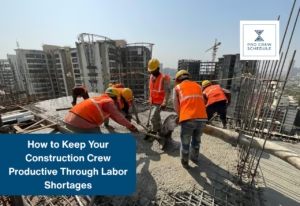This cannot be stressed enough – but the construction industry is prone to so many delays that place a significant time and cost impact on the contractor. This means that a lot of the work is not getting done because of problems that have not been solved, such as a lack of materials, a holdup in another part of the project, a lack of workers, and even inclement weather. Even though there will always be a time when there will be no progress on the job site, using the best planning and scheduling methods can make a big difference in how well things work. In this article, let us dive into short-interval scheduling and how it can work for you and your team.
What Is Short-Interval Scheduling?
Short interval scheduling is a method that considers that work is done in the field in a way that is constantly changing. Thus, it only schedules in short intervals by constantly evaluating dependencies and other constraints to keep work going smoothly. A crew scheduler needs careful planning to ensure the crews have what they need when they need it. Before the job starts, it lays out the expectations for safety, quality, productivity, cost, and completion.
How Does It Work?
Scheduling at short intervals increases productivity and reduces wasted work time due to delays. This is possible because short-interval scheduling makes it easy for supervisors to compare what work was done to what was initially planned and to figure out how to adjust the schedule. This scheduling strategy provides everyone on the team and the company with an overview of what is happening, ensuring everyone is on the same page.
Short-interval scheduling makes it easier to keep track of the people, tools, and materials needed for a given day and to figure out what causes waste and rework. Short-interval scheduling allows you to plan for what needs to happen before work starts and then check on the work’s progress at different times during the day. It also lets you monitor the roadblocks and interruptions throughout the day and how they affect your work immediately during the day. As a result, this scheduling strategy helps organizations save money on labor costs, which leads to higher profits and more revenue, which allows the bottom line.
How to Make a Strategy for Short-Term Scheduling
Construction projects are always challenging, whether you are a seasoned contractor, a project manager, or a newbie. It can be complex, tiring, and often take longer than expected. With many moving parts in the project, many problems are bound to happen with many people, machines, raw materials, and other factors. As a project manager, you need a well-thought-out plan and a carefully planned schedule.
A construction project starts when the owner decides that there is a need for a new building or improvement to the community. It ends when the installation is finished and approved by the proper authorities. During the time that the project is being done, a construction schedule is used to guide the project. Luckily, in the present day and age, you can utilize a construction schedule management system to make things easier and more organized.
In this section, five ways that you can create a short-interval schedule.
Define the Scope of Work and Your Deliverables
The first step in making a schedule is to find out as much as possible about the project and the people involved. What is your scope? Deliverables? What are your expectations once the project is completed? Tell your crew members what needs to be done and what will be expected. If you feel you need help with how and where to start, you can check with your stakeholders and subcontractors working on the project and ask them what they need.
One of the best ways to do so is to create work breakdown structures or WBS. It is a way where projects list all significant tasks and break them down into smaller, easier-to-handle, and workable parts. This helps them keep a closer track of everything going on with their projects and outcomes. It lists every aspect of the task in detail, its dependencies, and how it fits into the project’s bigger picture. Jobs make up your schedule and need to be collected, put in the correct order, and given to the right people. As a result, the work will be easier to handle and hold everyone accountable.
Sequence Your Tasks and Estimate Their Duration
Now that you have put your whole list of project tasks in order of when they need to start, you will need to give each one a certain amount of time to be done. Find out how many days it will take, how fast the crew will work, and when it will be done. If you have been a project manager in the industry for a long time, then you can estimate the time it takes for each activity to be completed. If you are a construction newbie, it might be a complete shot in the dark; however, you can consult your stakeholders for this.
You can also add milestones, which are essential points that mark the end of a large part of your project’s development. Milestones help your team stay on track because they can be counted. You can also figure out when the work needs to start and when it needs to end with just a simple glance.

Here are some tips that you can take note of:
- Does the project have to be done by a specific date, or do your subcontractors have set hours? If that is the case, you can plot your timelines starting from the completion date, then going backward.
- Refrain from squeezing in your durations. Remember that this is based on the idea that you start with enough time to finish the project or reach your goals. As a result, you should estimate accurate timelines for each task.
- As mentioned earlier, you can ask for help from your team and subcontractors. Try to coordinate with the person in charge of doing the task.
Delegate Each Task to The Right Team
This is where an effective construction crew management system will come into place. Once you have gathered and assigned all the tasks to finish a project successfully, it is time to monitor its progress. When workers and contractors know what is expected of them in terms of commitment and their contracts, they are more responsible and honest about their work. After you have been given the job, your schedule is ready to be released to your stakeholders.
Ensure you have enough resources and that every team or stakeholder has a manageable number of tasks. If you think a team is going slow with a job, you can check their situation and see if you can provide assistance or assign the task to another group. Add contingencies to your schedule to account for delays, leaves, or late deliveries. Consider planned holidays, employee sick, and vacation days. Keep some wiggle room in the schedule to allow for changes.
Compare Your Short-Interval Schedule with The Project’s Baseline Schedule
Now that all your project information, materials, tasks, and timelines are in place, it is essential to go over everything and ensure nothing is missing. During the planning stage, you create a baseline schedule that will be the basis for your project’s milestones and progress. While construction projects go differently than planned, the baseline schedule accurately shows how you want the project to go. By comparing it to your short-interval schedule, you can see which parts are unproductive. Missing even the most minor task can affect every study after it.
Your construction schedule is the plan for you, your team, subcontractors, clients, and other stakeholders to follow. It is just as important to look it over carefully before sharing it as it is to measure twice and cut once.
Be Open and Flexible to Change
Plans need regular reviews of completed tasks to fix changes and reduce risks. The same applies to your construction schedule. Keep checking in on your schedule from time to time to see how things are going and prepare for any potential problems or risks that may come up in the future. When you flag a potential roadblock to your project, you must immediately discuss and reflect it in your schedule. The team working on the construction needs to know what problems they are facing to create solutions.
Key Takeaway
Short-interval scheduling might seem scary and intimidating, but it will become easier once you get going. Many supervisors on the front lines have never been taught how to plan and make schedules. Effective crew schedule planning well takes time and is not easy, and adapting to change the same way. Short-term scheduling allows you to adjust timelines based on the current condition of your project, letting you get a bird’s eye view of its productivity and efficiency.






